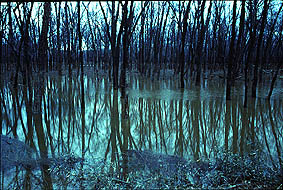
Bottomland forest.

Plants: Aquatic and wetland plants thrive over much of the American Bottom. At the river's edge, where currents and wave action actively scour away both sediment and new plant growth, the plant community is sparse compared to other parts of the floodplain. Immediately adjacent to this scoured river edge is a regularly inundated zone where scrub willows, cottonwoods, and herbaceous plants such as ragweed, knotweed, and sedge abound. In the low areas immediately adjacent to lakes, sloughs, and streams, vegetation is thicker and more diverse. It includes species such as pin oak, green ash, hackberry, persimmon, black willow, sycamore, honey locust, elm, and box-elder. The economically important Chenopodium sp., or goosefoot, also is common here as are a variety of scrubby plants including holly, birch, and buttonbush. Willows, cottonwoods, maples, pecans and other water-tolerant, pioneering trees grow in or near these wet areas. Several species of vines including grape and poison ivy envelop these bottomland forests.